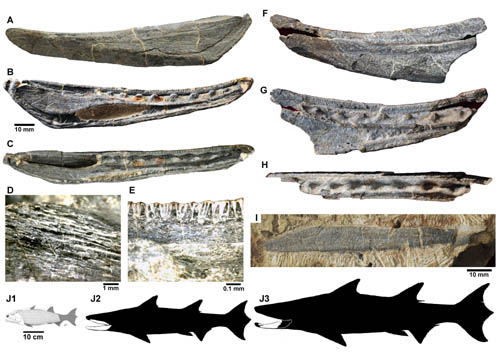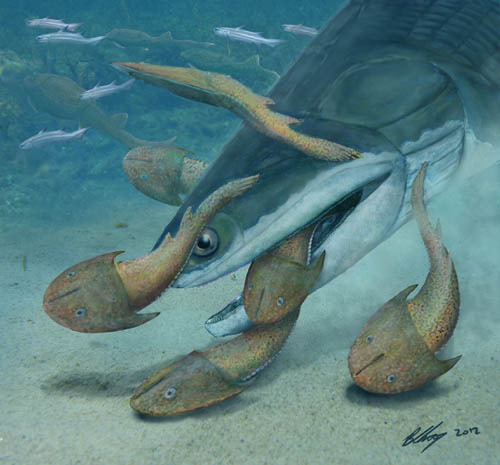| Location: Home > Research > Research Progress |
| Largest Silurian Vertebrate Discovered from Yunnan, China |
|
An apparent absence of Silurian fishes more than half-a-metre in length has been viewed as evidence that gnathostomes (jawed vertebrates) were restricted in size and diversity prior to the Devonian. A team led by Professor ZHU Min, Institute of Vertebrate Paleontology and Paleoanthropology (IVPP) of the Chinese Academy of Sciences has unearthed a bony fish with an estimated length of about 1 meter from the Silurian Kuanti Formation in Yunnan Province of southwestern China, revealing that pre-Devonian gnathostomes could attain comparatively large sizes. The study published June 12 in the journal of Scientific Reports adds new evidence to the theory that animals with backbones and jaws first developed in what is now China and also challenges current theories regarding atmospheric oxygen levels during early Earth history. The new species was based on a complete left mandible, a partial left mandible and a right maxilla, recovered from the Kuanti Formation (late Ludlow, about 423 million years ago), at a hill close to the Xiaoxiang Reservoir, Qujing, Yunnan, southwestern China. Other fishes from this horizon include the galeaspid Dunyu, the remarkable placoderm Entelognathus, and the osteichthyan Guiyu. The new species name, Megamastax amblyodus, is derived from megalos and mastax (Greek), meaning "big mouth", and the specific epithet is derived from amblys and odous (Greek) meaning "blunt tooth". The jaw was approximately 16 cm in length. The size of the jaw and teeth allowed the researchers to suggest the entire fish, when alive, would have been approximately 1 meter long. The teeth in front were sharp, for grabbing, while those in the back were clearly meant for grinding, likely hard shelled prey. “Megamastax amblyodus is the largest vertebrate known in the Silurian fossil record. The unusual dentition, combined with its large size, indicates a considerable degree of trophic specialisation among early osteichthyans”, said Dr. ZHU Min of IVPP, corresponding author and project designer. The apparent small size and limited diversity of Silurian gnathostomes has recently been employed as a constraint in paleoatmospheric reconstruction. Models of atmospheric history based on geochemical data indicate a mid-Palaeozoic episode of global oceanic oxygenation, likely linked to the formation of a global terrestrial vascular flora and the concurrent widespread burial of organic matter and roughly coinciding with the appearance of large gnathostomes in the fossil record. “Regardless of the exact causal relationship between oxygen availability and evolutionary success, this finding refutes the assumption that pre-Emsian vertebrates were restricted to small body sizes”, said lead author Dr. Brian Choo of the IVPP and now Flinders University, South Australia, “A large fish such as Megamastax couldn't survive in a time period that until this new discovery was thought to be characterized by low atmospheric oxygen levels, thus, levels must have been higher”. This research was funded by Major Basic Research Projects of China, Natural Science Foundation of China, and National Major Scientific Instrument and Equipment Development Project of China.
Fig.1 Fossils of Megamastax amblyodus. (A–E) Holotype mandible (IVPP V18499.1) in (A) lateral, (B) lingular, and (C) dorsal views; close-up of prearticular bone, showing surface ridges (D), and close-up of the marginal dentition in lingual view (E). (F–H) Partial mandible (V18499.2) in (F) lateral, (G) lingular, and (H) dorsal views. (I) Right maxilla (V18499.3) in lateral view. (J) Reconstruction of Guiyu oneiros (J1) alongside hypothetical silhouettes of Megamastax (J2–3) with superimposed fossil outlines (Image by Brian Choo).
Fig.2 Life reconstruction of Megamastax amblyodus consuming the galeaspid Dunyu longiforus (Image by Brian Choo)
|

